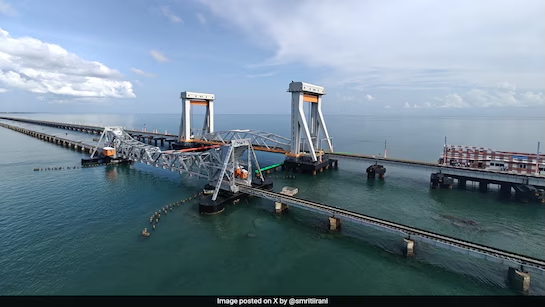Lagatar24 Desk
Rameswaram: Prime Minister Narendra Modi on Sunday inaugurated the new Pamban rail bridge in Tamil Nadu, coinciding with the auspicious occasion of Ram Navmi. This state-of-the-art structure is India’s first vertical-lift sea bridge and restores railway connectivity between mainland India and the spiritual destination of Rameswaram Island, one of the Char Dham pilgrimage sites.
PM Modi inaugurated the bridge remotely and flagged off the inaugural run of the Rameswaram-Tambaram Express. The bridge’s lift mechanism was demonstrated in real-time as a Coast Guard vessel passed underneath.
Constructed at an approximate cost of Rs 700 crore, the new Pamban bridge replaces the century-old original, which had been decommissioned in December 2022 due to corrosion.
Rameswaram-Tambaram Express: Timings and Stoppages
- Train No. 16103 (Tambaram to Rameswaram): Departs Tambaram at 18:10 hrs, arrives Rameswaram at 05:40 hrs next day.
- Train No. 16104 (Rameswaram to Tambaram): Departs Rameswaram at 16:00 hrs, arrives Tambaram at 03:45 hrs next day.
Stoppages: Ramanathapuram, Paramakkudi, Manamadurai, Sivaganga, Karaikudi, Aranthangi, Pattukotai, Thiruthuraipoondi, Tiruvarur, Mayiladuthurai, Chidambaram, Tiruppadiripuliyur, and Villupuram.
Rameswaram is now linked by 15 pairs of trains, including 14 extended services from Mandapam and one new daily service from Tambaram.
Salient Features of the New Pamban Rail Bridge:
- Length: 2.07 km
- Vertical Lift Span: 72.5 metres; rises to 17 metres for vessel passage
- Speed Capacity: Built to support speeds up to 160 kmph (currently capped at 80 kmph)
- Track Support: Foundation built for double lines, currently single-line in use
- Durability: Engineered for a lifespan of 100 years
- Materials & Protection: Includes stainless steel reinforcement, fully welded joints, and high-grade protective paint with a polysiloxane coating to prevent corrosion
Engineering Challenges & Innovation: The bridge was built under challenging conditions in the Palk Strait, including strong sea currents, high winds, and cyclone-prone weather. Advanced construction techniques were implemented, including:
- Auto Launching Method based on Relationship Principle
- PAUT (Phased Array Ultrasonic Testing) for precision weld inspections
Legacy & Modernization: The original bridge, built in 1914, served for over 105 years with a manually operated Scherzer’s span. Its decommissioning led to the approval of a replacement bridge in February 2019 by the Ministry of Railways, ushering in a new era of maritime-rail connectivity.









